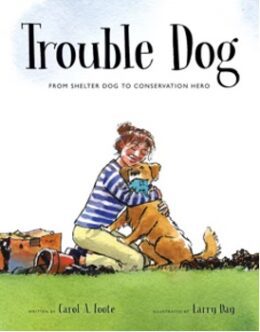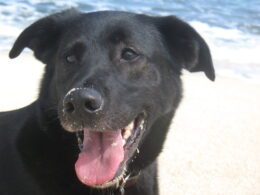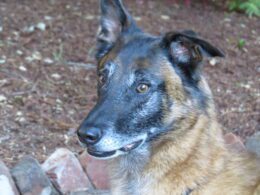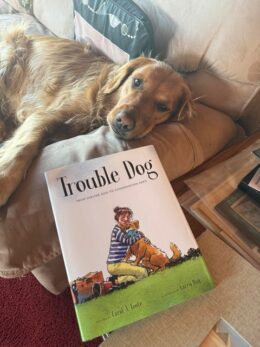 Today I welcome Carol A. Foote to Best Dog Books, a blog that features interviews with authors who’ve written a canine story for kids or young adults. Carol is a former freelance science writer and photojournalist with master’s degrees in history and journalism. She taught science writing and photojournalism at the University of California, Santa Cruz. Her work has appeared in the New York Times, the Los Angeles Times, and popular science magazines. Besides writing, photography, and travel, she loves history, science, reading, and taking her own dog, Lily, for long walks in the hills near her home in California. Trouble Dog is her debut picture book, a Spectacular STEAM for Curious Readers book, and perfect for fans of dogs, science, second chances, and a feel-good story.
Today I welcome Carol A. Foote to Best Dog Books, a blog that features interviews with authors who’ve written a canine story for kids or young adults. Carol is a former freelance science writer and photojournalist with master’s degrees in history and journalism. She taught science writing and photojournalism at the University of California, Santa Cruz. Her work has appeared in the New York Times, the Los Angeles Times, and popular science magazines. Besides writing, photography, and travel, she loves history, science, reading, and taking her own dog, Lily, for long walks in the hills near her home in California. Trouble Dog is her debut picture book, a Spectacular STEAM for Curious Readers book, and perfect for fans of dogs, science, second chances, and a feel-good story.
Carol is here to talk about Trouble Dog: From Shelter Dog to Conservation Hero , illustrated by Larry Day and published by Eerdmans Books for Young Readers for kids 5 – 9 years. Trouble Dog is available wherever you can buy books and a Junior Library Guild selection.
 Who is your key dog character and what kind of dog is he/she?
Who is your key dog character and what kind of dog is he/she?
My dog hero, Tucker, is a composite of two real dogs from Working Dogs for Conservation, Pepin and Wicket. In the illustrations, Tucker is mostly golden retriever, but lots of different breeds can be conservation dogs—labrador retrievers, border collies, German shepherds, golden retrievers, Belgian Malinois, and mixed breeds.
Tell us about your story.
Trouble Dog is the story of a smart, energetic dog who is abandoned at a shelter for being too much trouble, but he is recognized for his talents by a conservationist and given love, a home, and a new life traveling the world to help save wildlife. It’s based on the real lives and adventures of Pepin and Wicket, who became canine heroes with Working Dogs for Conservation, the world’s largest and oldest conservation dog organization.
 What inspired you to write this story?
What inspired you to write this story?
Like a lot of people, I’d never heard of a conservation dog. I saw my first one, Pepin, at an annual Wildlife Conservation Network (WCN) expo in San Francisco. Pepin’s handler, Megan Parker, who later became one of my main sources for the book, had Pepin demonstrate his talented nose by hiding things for him to find. She described how conservation dogs help biologists by sniffing out invasive plants and animals not easily detected by humans, and by finding the scat of rare or endangered species so scientists can study the animals without disturbing them.
Being a lover of dogs and wildlife, I was immediately intrigued and wanted to know more, but what touched my heart and inspired me to write this story was learning that these remarkable dogs are often abandoned at shelters and marked as trouble because they’re too rambunctious and full of energy to make good pets. Fortunately, organizations like Working Dogs for Conservation have learned to search shelters for such dogs and give them a second chance at life. The same qualities that make them trouble, their nonstop energy and intense focus, help them become great conservation dogs. I knew right away that I wanted to write that story—of a rejected dog being rescued, celebrated for his incredible abilities, and finding his place in the world.
 What was the biggest challenge you had writing your story? How did you overcome it?
What was the biggest challenge you had writing your story? How did you overcome it?
My biggest challenge might have been inertia! It was all too easy for me to keep putting off the writing. Fortunately, one morning I woke up with an opening line in my head and told myself I had to start. That beginning did not become the final opening, but it got me going, which was what I needed.
Once I started, the challenge was getting the right balance between the story, information, and emotion. I had an enormous number of revisions ahead of me. In early drafts, I was carried away writing too much about Tucker’s antics and his being taken to the shelter. Eventually I realized that I could leave much of that to the illustrator and have more room to write about his training and adventures in the field.
What kind of story can we expect next from you? Is it about a dog? If so, what can you tell us about it?
I have another picture book in the works that also deals with conservation and is based on a true story. It’s about a wild cheetah in Botswana and the young girl whose love for cheetahs helps save its life. A dog does factor into the story but in a much smaller role. I’m also working on a middle grade time travel novel. As much as I love science and nature, I also love the idea of visiting history through time travel.
What else would you like us to know about you or your story?
I hope readers will take away the idea that everyone has value and is capable of doing amazing things, even if their strengths haven’t been recognized yet. I love that this story has that message at its core. As much as it is about the enduring relationship between dogs and humans, and about the positive work being done in the field of conservation, it’s also about everyone having worth and a place in the world.
 Can you remember the first book that made an impact on you? Why?
Can you remember the first book that made an impact on you? Why?
The first book I remember being passionate about was MARY POPPINS. I loved reading about real kids who found magic in the everyday world. After that I couldn’t get my hands on enough books that let me imagine magic in my own life.
What advice would you give to aspiring writers?
Start. Don’t wait until you think it will be perfect, or even good. It can be hard to start writing because you know that first draft is not going to be right. Your first draft might even be terrible. You just have to face that and get going so you can make it better.
Also, and this is even harder, don’t be discouraged by rejection. It’s tough trying to succeed in a field where part of the process, almost always, is getting turned down. Accept that’s the path and keep going.
Oh and, join a critique group. It’s invaluable to have other writers you build trust with and can take honest criticism from.
Where can people find/connect with you online?
My website is www.carolafoote.com
I’m also on Instagram @carolafootewriter and Facebook as Carol A Foote.
 As a debut PB author, share with us one thing that surprised you in the publishing process?
As a debut PB author, share with us one thing that surprised you in the publishing process?
This will probably sound obvious, but I was surprised by how much others contributed to creating this book and making it what it is. I’m so grateful. The book wouldn’t exist if not for all the help I had every step of the way—the people I interviewed at Working Dogs for Conservation, critique partners and friends, my supportive family, my agent for her super helpful editing suggestions, Larry Day for his beautiful illustrations that bring the book to life, everyone at Eerdmans Books for Young Readers, who all did more than I could have imagined, and now bloggers and reviewers who are helping to spread the word. Everyone congratulates me as the author, but really the book is the result of the efforts of a huge number of people who were all incredibly generous with their time. That has really hit me.
Thank you, Carol, for giving us your time today and for sharing your journey with us!


